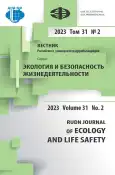Methodological approaches to the electromagnetic radiation effects on microorganisms
- Authors: Shcheglov G.A.1, Masloboev V.A.1
-
Affiliations:
- Institute of Industrial Ecology Problems in the North, Kola Science Center, Russian Academy of Science (INEP KSC RAS)
- Issue: Vol 31, No 2 (2023)
- Pages: 179-190
- Section: Ecology
- URL: https://journal-vniispk.ru/2313-2310/article/view/323936
- DOI: https://doi.org/10.22363/2313-2310-2023-31-2-179-190
- EDN: https://elibrary.ru/YUFUXW
- ID: 323936
Cite item
Full Text
Abstract
All living organisms are surrounded by natural and artificial origin electromagnetic radiation (EMR), which affects organisms. The artificial radiation sources number is increasing, but the EMR influence mechanisms on living organisms have not yet been fully investigated, despite the large number of studies. However, understanding the EMR action mechanisms can give impetus to the development of various biotechnologies. To solve the problem of understanding the EMR effects on organisms and develop new biotechnologies, it is necessary to apply new research methods. Therefore, the study of research methods is an urgent task. This research is a review of studies and research methods on the effects, of EMR on organisms. It brings together studies that consider different approaches to the study and existing hypotheses of the mechanisms of radiation effects. The aim of the paper is to review and evaluate methodological approaches to investigate the effects of EMR. The paper considers research on the EMR effects on microorganisms, eubacteria. Based on the results of the work, it is proposed to study the effect of radiation lasting several hours. As well as to apply spectrophotometry and fluorimetry methods.
About the authors
Gleb A. Shcheglov
Institute of Industrial Ecology Problems in the North, Kola Science Center, Russian Academy of Science (INEP KSC RAS)
Email: g.scheglov@ksc.ru
ORCID iD: 0000-0003-2870-3616
Engineer
14a Fersman St, Apatity, Murmansk region, 184209, Russian FederationVladimir A. Masloboev
Institute of Industrial Ecology Problems in the North, Kola Science Center, Russian Academy of Science (INEP KSC RAS)
Author for correspondence.
Email: v.masloboev@ksc.ru
ORCID iD: 0000-0002-1536-921X
D. in Engineering, Chief Scientist
14a Fersman St, Apatity, Murmansk region, 184209, Russian FederationReferences
- Gapochka MG. Ecological aspects of interaction of electromagnetic fields of the millimeter range with biological objects (dissertation of the Doctor of Biological Sciences). Moscow; 2013. (In Russ.). Available from: https://www.elibrary.ru/item.asp?id=30397922
- Beczkij OV, Kotrovskaya TI, Lebedeva NN. Millimeter waves in biology and medicine. Radar and radio communication. III Russian Scientific Conference. Moscow; 2009. p. 146–150. (In Russ.)
- Kasyanenko AA, Evdokimova OV, Baryshev MG. The attempt to reduce harmful influence of electromagnetic radiation upon biological systems with usage of modern fabrics. RUDN Journal of Ecology and Life Safety. 2005;(1):132–134. (In Russ.)
- Lipiec J, Janas P, Barabasz W. Effect of oscillating magnetic field pulses on the survival of selected microorganisms. Int. Agrophysics. 2004;18(4):325–328.
- Cellini L, Grande R, Di Campli E, Di Bartolomeo S, Di Giulio M, Robuffo I, Mariggio MA. Bacterial response to the exposure of 50 Hz electromagnetic fields. Bioelectromagnetics. 2008;29(4):302–311.
- Li ZY, Guo SY, Li L, Cai MY. Effects of electromagnetic field on the batch cultivation and nutritional composition of Spirulina platensis in an air-lift photobioreactor. Bioresour. Technol. 2007;98(3):700–705.
- Solnyshkova MA. Reduction of surface water pollution by inorganic nitrogen compounds in the impact zone of mining enterprises of the Murmansk region (dissertation of the Сandidate of Technical Sciences). Saint Petersburg; 2020. (In Russ.) Available from: https://goo.su/N55RjSd (accessed: 28.09.2022).
- Sukhovsky NA. The presence of an electrostatic field in an electrostatic bioreactor. Bulletin of the Agroindustrial complex of the Upper Volga region. 2015;(1):92–94. (In Russ.)
- Kozmin GV, Egorova EI. Stability of biocenoses in conditions of changing electromagnetic properties of the biosphere. Biomedical technologies and radioelectronics. 2006;(3):61–72. (In Russ.)
- Ryzhkova TA, Kalinichenko SV, Babich EM, Korotkov EO, Hvorostyanaya VA, The effect of electromagnetic radiation of the millimeter range on the ability of pathogenic corynebacteria to form biofilms. Living and biocontainable systems. 2015;1(14):1–9. (In Russ.)
- Shlyakhtin GV, Zotova EA, Malinina YuA. Changes in the biological activity of cells under the combined action of electromagnetic radiation of extremely high frequencies and nicotine. Proceedings of the Samara Scientific Center of the Russian Academy of Sciences. 2007;9(4):818–822. (In Russ.)
- Gapochka MG. The influence of low-intensity electromagnetic radiation on the toxicity of the aquatic environment. VMU physics astronomy. 2009;1:67–69. (In Russ.)
- Nerkararian AV, Shaginyan MA, Khachatryan AV, Vardevanyan PO. The effect of low-intensity non-thermal coherent EHF EMR on the overall activity and isoenzyme composition of peroxidase. Biological Journal of Armenia. 2011;63(4):96–103. (In Russ.)
- Zarubina AP, Vapochka MG, Novoselova LA, Gaspochka LD. Biostatistics tet-system “Ecolum” the effect of the electromagnetic flow of low intensification on the toxicity of existing effluents. Bulletin of the Moscow University. 2012;16(3):39–43. (In Russ.)
- Pronina EA, Shub GM, Shvidenko IG. Plasmid gene expression of escherichia coli drug resistance under the influence of electro8magnetic radiation. RUDN Journal of Ecology and Life Safety. 2009;(3):5–9. (In Russ.)
- Darovskikh SN, Shishkova YuS, Trusteitelev EP, Tseilikman OB, Vdovina NV, Lapshin MG. Radiovibration mechanism interaction of biological tissue of the organism with electromagnetic fields and radiation. RUDN Journal of Ecology and Life Safety. 2014;14(3):5–10. (In Russ.)
- Kalaji HM, Jajoo A, Oukarroum A, Brestic M, Zivcak M, Samborska IA, Ahmad P. The Use of Chlorophyll Fluorescence Kinetics Analysis to Study the Performance of Photosynthetic Machinery in Plants. Emerging Technologies and Management of Crop Stress Tolerance. 2014;347–384.
Supplementary files









